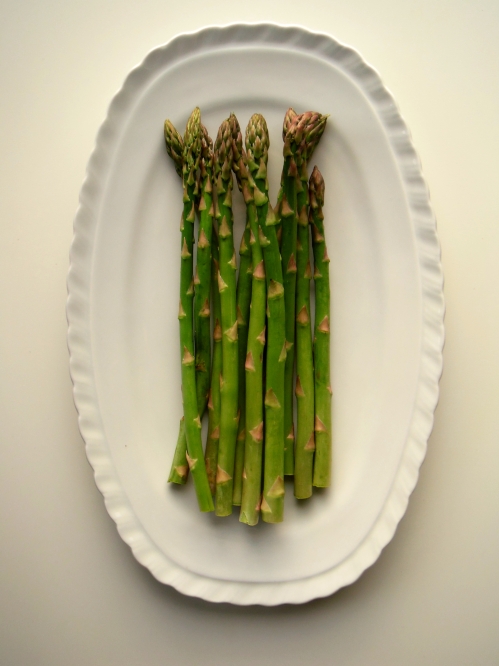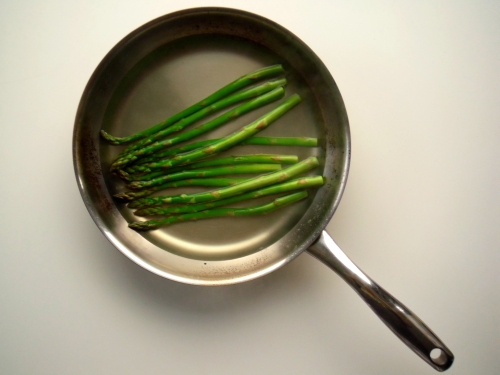Godly Greens: My green asparagus with two sauces.
by cookingbrains09
 I love my food to be a bit luxurious. A slight hint of decadence, paired with a bit of nutmeg and a nice chilled white wine. Spring is the perfect season for the kind of food you would expect at a posh British farmhouse for brunch. Simple but with the extra touch, that goes a long way. For me nothing expresses this romantic image of a slightly vintage -and decidedly hipstereque- posh meal better than asparagus with hollandaise. There is something naughty, almost forbidden about spooning a rich, yet light, butter sauce over a vegetable that can only be eaten for a short period in spring. If you want to treat yourself and those you love to a decadent dish, celebrating spring, have a go at my green asparagus with two sauces. The light and buttery sauce hollandaise and a ridiculously easy nutty cream-sauce are just the right accompaniment for the fragile and subtle spears.
I love my food to be a bit luxurious. A slight hint of decadence, paired with a bit of nutmeg and a nice chilled white wine. Spring is the perfect season for the kind of food you would expect at a posh British farmhouse for brunch. Simple but with the extra touch, that goes a long way. For me nothing expresses this romantic image of a slightly vintage -and decidedly hipstereque- posh meal better than asparagus with hollandaise. There is something naughty, almost forbidden about spooning a rich, yet light, butter sauce over a vegetable that can only be eaten for a short period in spring. If you want to treat yourself and those you love to a decadent dish, celebrating spring, have a go at my green asparagus with two sauces. The light and buttery sauce hollandaise and a ridiculously easy nutty cream-sauce are just the right accompaniment for the fragile and subtle spears.
When talking to friends about food or when reading blogs and cookbooks, I often come across the notion of a “difficult dish”. And as much as I like alliterations, I always found it hard to relate to this idea, the concept of cooking as something complicated. I mean sure, there is the notorious soufflé – a dish that makes the best chefs in the world quiver (at least that’s what Gordon Ramsay says whenever he makes people cook soufflés on MasterChef). But really, when you look at it, it is only making sure to integrate as much air as you can and to keep your fingers away from the ovendoor. It isn’t that hard really. All it takes is a lot of patience and a bit of courage. And I think that this is what cooking comes down to, as Julia Child put it “You just have to have the courage of your convictions”. You need to believe that what you are about to do is actually possible and not just for any hypothetical person, but very specifically for you. And why wouldn’t you, before having tried something new, there is no evidence for a possible failure. This is not to say that you won’t fail every now and then, because more often than not you will. At least if you are anything like me. But instead of taking this as evidence for your own incapability (if you are more of an internal locus of control type of person) or the impossibility of a dish (if you are big on the external locus of control) and to be over and done with it, you might want to find it in you to just go at it again. And again, if necessary. And again. Because eventually you will succeed, or -for what it’s worth- improve.
When I was about eleven or twelve my best friend used to play the drums. I remember, that on the wall next to where all the noise-makers were assembled there was a laminated sign, hung up by a well-meaning mother, it read something along the lines of “Be happy for every mistake you make, because it is only our errors we can learn from”. I still wonder whether or not it was a clever move to encourage an eleven year old to make as many noisy mistakes as possible – even a mother’s ear can only tolerate such much noise, but still the message stuck with me. I wouldn’t go as far as saying that I have lived after these words ever since, because I haven’t. I still find failing at something utterly unpleasant and possibly anger-provoking. But I have come to realize that you can actually learn quite a bit about yourself from the mistakes you make in the kitchen. Many dishes are difficult for me, because they require focus and patience. Two traits I often lack. There is no rushing a soufflé or a sauce hollandaise and especially when working with eggs focus is required. But instead of being well prepared and having all the things I need at hand, I maniacally stir a sauce with my left hand, so that I can use my good right hand to chop some chives while talking to one of my roommates, and over all this action I miss the crucial point and scramble my eggs or split a sauce beyond saving.
Everything about this dish is simple: the asparagus is cooked in a spell and the cream sauce requires almost no work, this leaves you with enough time to fully focus on my lovely rich and light sauce hollandaise.
My green asparagus with two sauces
The Asparagus
When making this dish, make sure to choose the freshest produce you can get. I use green asparagus here, but white will do just as fine, maybe even better. Fresh asparagus will have a firm head, a moist bottom end and squeak a bit, when you rub two spears against each other. Uncooked spears keep well, wrapped in a damp towel, in your fridge for day a two. Before cooking, rinse them under cold water and sniff every head – discard of the spears that smell fishy.
Bring a large pan with water to a soft boil, add salt and sugar to the pan (you should be able to taste both salt and sugar, but the water should neither be salty nor sweet). Add the spears to the water and cook for about two to three minutes. I prefer mine rather tender, but you might like them a bit more crunchy.
My quick and easy Hollandaise
For each person I use one yolk and 100 g of butter.
This sauce is not complicated but can be a bit tricky. I think that working with eggs requires a quick hand and patience, the egg needs to be heated, but can’t be hot. Have a bowl with cold water ready, so that you can cool down the sauce when necessary. You might not be as successful the first or second time around, but give it a shot, it will definitely be worth it. Julia Child suggests that this sauce can be made both in a bain-marie (which is the fancy name for fitting a bowl over a pan of softly boiling water) or directly in a sauce pan. Since my gas-stove is too hot, or rather my hands not quick enough, I prefer using a bain-marie for this. But knock yourself out.
I find it hard to make this sauce from only one egg-yolk, which is why I use at least two. The sauce keeps well in the fridge for a day or two and can be spooned over almost anything, it goes nicely on a bit of crunchy baguette and a glass of white wine.
Gently melt about 2/3 of the butter (140 g). In the meantime, bring a pan of water to a soft boil. Fit a bowl to the pan and add two yolks to the bowl (save the whites, maybe make a nice egg-white omelette with them). With a whire whisk, mix the yolks. Add about half a tablespoon of water, a teaspoon of lemon juice and a bit of salt for each yolk. Whisk the content of the bowl until it is starting to thicken. The yolks will turn slightly pale and foam will start to form, the mix is thick enough once you can see the bottom of the bowl between strokes. By the slightest sign of scrambling, put the bottom of the bowl in the cold water and stir until the eggs have cooled down.
Add the remaining third (60g) of the unmelted butter in small cubes to the bowl. Stir and wait for each cube to incorporate, then add the next. Add the melted butter to the mix, drop by drop. This is the bit where I usually fail, because I’m not patient enough. Make sure to start with one drop and one drop only, later you may add more melted butter at a time, but be careful to integrate the fat fully, before you add more. Once all the butter has been incorporated you should be left with a pale, thick sauce. I like to slowly add a bit of water to make the sauce thinner and to add some additional lemon juice for more freshness. Season to the taste. This sauce should be served warm, never hot – or the egg will start to coagulate. Often it will be enough to just spoon it over some warm (not hot) food, to bring it up to temperature.
My nutty cream-sauce.
This is a reduced cream-sauce and probably one of the easiest and yet most delicious sauces you will ever make. Think about how much sauce you will need and use double the amount in single cream. A bit of nutmeg, pepper, salt and lemon juice might be necessary too.
This sauce is basically a cream-reduction. The more heat you add, the nuttier the flavour. The time required for this depends on the amount of cream you need to reduce and the width of the pan used. I calculate about 30 minutes per 200 ml of cream in a 12 cm pan. This sauce can be easily reheated, so making it in advance or keeping it in the fridge won’t be a problem.
The instructions are easy: Add the single cream to a pan and set over low heat. Stir occasionally and let reduce to about half (or more… or less, whatever you like). Season with salt and pepper, some nutmeg and a squeeze of lemon directly before serving. The sauce should be warm, not hot – or it will split. Spoon over the cooked asparagus and enjoy with some potatoes or bread or just as it is.
Once your sauce cools down it will become rather thick. If you want to reheat it, add a few tablespoons of water and gently reheat it, stirring thoroughly.


